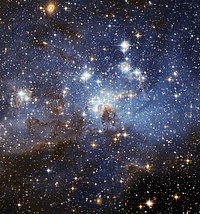
Effects of flares on the habitable zones of M dwarfs accessible to TESS planet detections
Sign Up to like & getrecommendations! Published in 2021 at "Astronomische Nachrichten"
DOI: 10.1002/asna.20210079
Abstract: This is the pre-peer reviewed version of the following article: M. Bogner, B. Stelzer, and St. Raetz (2021), Effects of flares on the habitable zones of M dwarfs accessible to TESS planet detections, which has… read more here.
Keywords: planet; effects flares; habitable zones; flares habitable ... See more keywords

Systematic simulations of FFP scattering by a star–planet pair
Sign Up to like & getrecommendations! Published in 2019 at "Celestial Mechanics and Dynamical Astronomy"
DOI: 10.1007/s10569-019-9931-3
Abstract: The increasing number of free-floating planets discovered in recent years confirms earlier theoretical predictions and leads us to believe that the possibility of such an object intruding an existing planetary system is not negligible, especially… read more here.
Keywords: planet pair; planet; ffp; star planet ... See more keywords

Application of advanced technology to build a vibrant environment on planet mars
Sign Up to like & getrecommendations! Published in 2017 at "International Journal of Environmental Science and Technology"
DOI: 10.1007/s13762-017-1354-7
Abstract: In order to make Mars a better planet, in this paper, photo-dissociation technology, mathematical modeling, and a series of chemical reaction methodology have been proposed to create a vibrant ecosystem and balance the atmosphere on… read more here.
Keywords: planet; vibrant environment; reaction; technology ... See more keywords

‘Raising the temperature’ : the arts on a warming planet
Sign Up to like & getrecommendations! Published in 2018 at "Current Opinion in Environmental Sustainability"
DOI: 10.1016/j.cosust.2017.12.010
Abstract: The search for decisive actions to remain below 1.5 °C of global temperature rise will require profound cultural transformations. Yet our knowledge of how to promote and bring about such deep transformative changes in the minds… read more here.
Keywords: arts warming; raising temperature; temperature; planet ... See more keywords

Is Gaia alive? The future of a symbiotic planet
Sign Up to like & getrecommendations! Published in 2018 at "Futures"
DOI: 10.1016/j.futures.2018.07.010
Abstract: Abstract Life affecting first the development of the planetary environment, which, in turn, affects the future evolution of life in a coevolutionary way is a well-established idea now. Nevertheless, with the proposal of the Gaia… read more here.
Keywords: gaia alive; alive future; teleology; planet ... See more keywords

United theory of planet formation (i): Tandem regime
Sign Up to like & getrecommendations! Published in 2017 at "New Astronomy"
DOI: 10.1016/j.newast.2016.11.001
Abstract: Abstract The present paper is the first one of a series of papers that present the new united theory of planet formation, which includes magneto-rotational instability and porous aggregation of solid particles in an consistent… read more here.
Keywords: disk; planet; formation; regime ... See more keywords

Limits on the orbits of possible exomoons around Kepler giant planets in the habitable zone
Sign Up to like & getrecommendations! Published in 2020 at "Planetary and Space Science"
DOI: 10.1016/j.pss.2020.105033
Abstract: Abstract Regions of Hill stability were determined using the full three-body theory for the planetary candidates that were found by the Kepler mission to lie in the Habitable Zone of the host star with radii… read more here.
Keywords: habitable zone; moon; planet; planets habitable ... See more keywords

The diagnostic analysis of the planet bearing faults using the torsional vibration signal
Sign Up to like & getrecommendations! Published in 2019 at "Mechanical Systems and Signal Processing"
DOI: 10.1016/j.ymssp.2019.106304
Abstract: Abstract This paper aims to investigate the effectiveness of using the torsional vibration signal as a diagnostic tool for planet bearing fault detection. The inner race of the planet bearing is connected to the planet… read more here.
Keywords: race; planet bearing; planet; torsional vibration ... See more keywords

Dust from Colliding Asteroids Masqueraded as a Planet
Sign Up to like & getrecommendations! Published in 2020 at "Eos"
DOI: 10.1029/2020eo143057
Abstract: New analysis of Hubble Space Telescope images suggests that Fomalhaut b, once believed to be an extrasolar planet, is, in fact, a cloud of dust that likely formed from the collision of enormous asteroids. read more here.
Keywords: dust colliding; planet; asteroids masqueraded; masqueraded planet ... See more keywords

Evidence for the start of planet formation in a young circumstellar disk
Sign Up to like & getrecommendations! Published in 2018 at "Nature Astronomy"
DOI: 10.1038/s41550-018-0497-x
Abstract: The growth of dust grains in protoplanetary disks is a necessary first step towards planet formation1. This growth has been inferred from observations of thermal dust emission2 towards mature protoplanetary systems (age >2 million years)… read more here.
Keywords: planet; evidence; dust; growth ... See more keywords

Atmospheric dynamics of a near tidally locked Earth-sized planet
Sign Up to like & getrecommendations! Published in 2022 at "Nature Astronomy"
DOI: 10.1038/s41550-022-01626-x
Abstract: The discovery and characterization of Earth-sized planets that are in, or near, a tidally-locked state are of crucial importance to understanding terrestrial planet evolution, and for which Venus is a clear analog. Exoplanetary science lies… read more here.
Keywords: near tidally; planet; terrestrial planetary; earth sized ... See more keywords